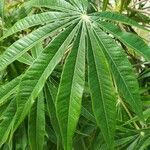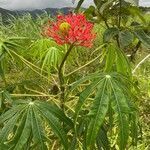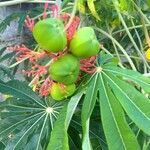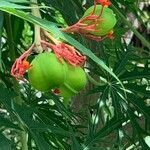Shrubs or trees, to 7 m, monoecious. Stems erect, yellow-brown, sparsely branched, woody-succulent, glabrous; short shoots absent; latex viscous, cloudy-whitish. Leaves persistent or drought-deciduous, mostly borne on or near branch tips; stipules persistent, (3–)6–15(–25) mm, filiform-divided; petiole 11–29 cm, not stipitate-glandular; blade ovate-cordate in outline, 16–30 × 10–22 cm, deeply 9–11-lobed nearly to base, base rounded, margins incised, apex acuminate, membranous, surfaces glabrous; venation palmate. Inflorescences bisexual, terminal and subterminal, cymes; peduncle 12–30 cm; bracts 2–4.5 mm, margins entire, glabrous. Pedicels 3.5–6 mm. Staminate flowers: sepals connate to 1/2 length, ovate, 1.5–3 × 1–1.2 mm, margins entire, apex round, surfaces glabrous; corolla orange-red, campanulate, petals distinct, 5–7 × 2.5–3 mm, surfaces glabrous; stamens 8 in 1 whorl; filaments distinct, 2.2–2.5 mm. Pistillate flowers resembling staminate, but sepals 2–3.5 × 1.1–1.3 mm; petals 6–8.2 × 2–3.2 mm; carpels (1–)3; styles distinct, 1–1.2 mm. Capsules ellipsoidal, winged, 3–3.4 × 2.7–2.9 cm, tardily dehiscent. Seeds yellow to light brown, mottled with dark brown spots or stripes, spheric, 14–18 mm; caruncle rudimentary. 2n = 22 (Puerto Rico).
Shrubs or treelets, 2-3(-6) m tall; stems glabrous. Stipules divided into forked setiform, to 2 cm; petiole 10-25 cm; leaf blade orbicular in outline, 10-30 cm wide, green adaxially, gray-green abaxially, glabrous on both surfaces, margin palmately 9-11-lobed, lobes entire; venation pinnate. Inflorescences terminal; peduncle 13-20 cm; pedicels short; flowers dense. Male flowers: calyx 2-3 mm, lobes 5, rotund, glabrous; sepals 5, spatulate, red, ca. 4 mm; stamens 8; filaments connate at base; anthers elongate. Female flowers: calyx as in male; sepals 6-7 mm, red; ovary glabrous; styles 3, connate in lower 1/2. Capsules ellipsoidal to obovate, ca. 3 cm, glabrous. Fl. Jul-Dec, fr. Sep-Feb.
A tree like shrub. It is succulent and keeps growing from year to year. It grows to 7 m high and spread to 4 m across. The stem is simple and has few branches. The stem is stocky and 3-6 cm thick. The leaves are rounded and with 7-15 lobes. This means the leaves are finely divided. The leaves are 20-40 cm across and leaflets 4-8 cm across. The flowers are small and bright red. They are on long stalks and many occur together. The flowers are 5 mm across. The fruit is a capsule 3-4 cm across. They contain up to 3 seeds.
Male flowers: pedicels up to 1 cm long, coral-red; calyx c. 2 mm long; calyx lobes c. 1 × 1 mm, broadly ovate, rounded and erose at the apex, otherwise entire, red; petals c. 5 × 2 mm, oblong-oblanceolate, rounded, scarlet; disk glands 5, free, turbinate, rounded; stamens 8, 4 mm long, filaments free, anthers 2 mm long, oblong-linear, sagittate.
Leaf blades up to 20 × 30 cm, (9)10–12-palmatipartite, bright green above, glaucous beneath; the lobes up to 15–17 × 7 cm, narrowly lanceolate or irregularly pinnatipartite, acutely long-acuminate, sometimes aristate, entire, confluent into a narrowly cordate basal disk; lateral nerves numerous.
Female flowers: pedicels 2 mm long; calyx and petals resembling those of the male, but c. 1.5 times larger; disk 2.5 mm in diameter, flattened, 5-lobed, with lobes rounded-truncate; ovary 3 × 2 mm, trigonous-ellipsoid; styles 2.5 mm long, united at the base, stigmas capitate, 2-lobed.
Fruit 2.5 × 2.8 cm when dried, somewhat larger when fresh, 3-lobed to pyriform, depressed at the apex, abruptly tapered to the base, the lobes slightly keeled, tardily septicidally dehiscent to subdrupaceous.
Inflorescences commonly up to 25 cm long, with a peduncle up to 22 cm long, densely corymbiform to subcapitate; bracts up to 5 mm long, lanceolate, acute, entire.
Seeds 1.7 × 1.5 × 1.3 cm, broadly ovoid-subglobose, buff, mottled brownish, ecarunculate.
A glabrous eglandular shrub usually up to 2 m high, sometimes taller.
A shrub or tree, up to 20 ft. high with stout glabrous branches
Stipules 1.5–2 cm long, multifid, the segments setaceous.
Petioles commonly up to 20 cm long.
Planted in villages.
Branchlets thick.
Coral-red flowers
Latex white.










